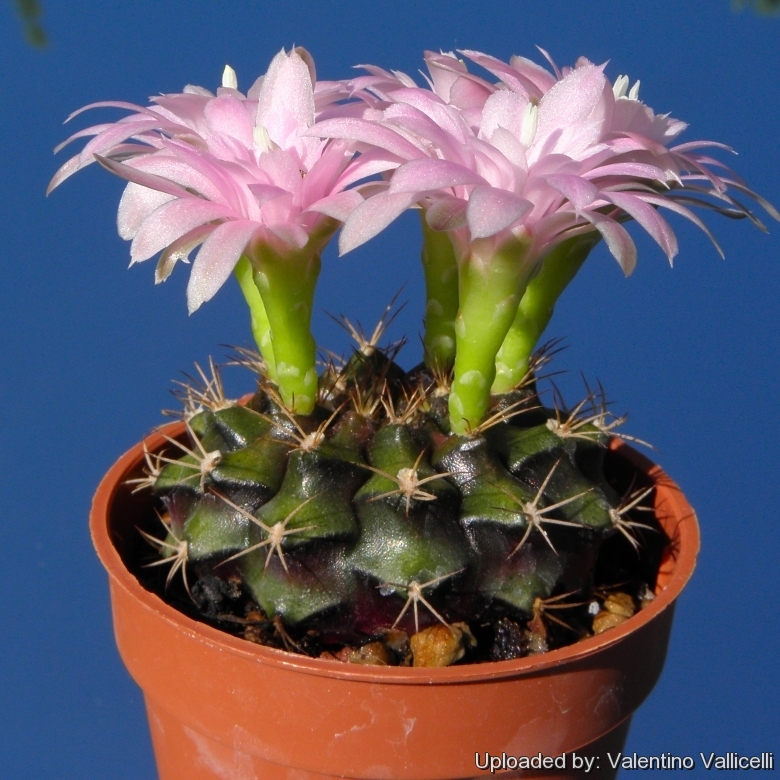
Gymnocalycium anisitsii Photo by: Valentino Vallicelli
Origin and Habitat: Gymnocalycium anisitsiiSN|13315]]SN|13315]] has a fragmented population spread over a large area in Brazil, Bolivia, Paraguay (extent of occurrence = 25,000 km2).
Altitude: It occurs at elevations of 70-400(-1000?) metres above sea level.
Habitat: It grows in open areas in semi-shade under the protection of low xerophyllous bushes that have no or very few leaves and rarely occurs on rocks in hills and in sandy mountain regions. The light filters through. The soil is usually a rich sandy loam. Rains are frequent during the summer. It often form large groups and is extremely variable. There are no known major threats to this species.
Synonyms:
See all synonyms of Gymnocalycium anisitsii
Description: Gymnocalycium anisitsiiSN|13315]]SN|13315]] is a very easy to grow and very free-flowering cactus, it may be solitary or freely offsetting with white flowers (but also pink). Spines 5 to 7, tortuous, up to 6 cm long. It is a very polymorphic species with a large range of variability. Two subspecies are recognized, the nominate form and subsp. multiproliferum.
Stem: Spherical-depressed to short cylindrical, 5-8(-10) cm tall, 8-10 cm in diameter, green, pale-green bronzing in full sun, and highly decorative, often with horizontal clear and dark strips.
Ribs: 8-11, acute, and more or less notched into chin-shape protrusions or warts.
Radial spines: 5-7 (rarely to 9), straight or slightly tortuous, 1-6 cm long, subulate, somewhat angled, nearly useless in terms of defence. Young spine are pastel-white, yellowish or brownish with a darker tip, later becoming pale-grey.
Central spines: Usually absent, sometimes one.
Flowers: From the centre, funnel form, typically greenish white, but also pale pink or bright vivid pink and showy, about4- 6 cm long. Scales and outer perianth-segments broad, greenish margins, internal tepals white, broadly oblong, acute or greenish spreading. Tube thin.
Blooming season: It produces flowers almost continuously during the year.
Fruits: Oblong, 2,5 cm long, 6-10 mm in diameter, reddish at maturity.
Seeds: Almost spherical, 1 mm, pale brown, hilum inconspicuous.
Remarks: Seems to be a pretty variable plant you might get some other names which are effectively the same plant.... and also not sure all plants identified as this are really this.
Subspecies, varieties, forms and cultivars of plants belonging to the Gymnocalycium anisitsii group
Gymnocalycium anisitsii is a very polymorphic species with a large range of variability. Two subspecies are recognized, the nominate form and subsp. multiproliferum. There seems to be very little justification for vars. centrispinum, rotundulum, torulosum and tucavocense. Gymnocalycium griseopallidum from the salt-pan desert area on the Bolivia-Paraguay borders may well be another variety or local form which has become adapted to the peculiar local conditions of that region.
 Gymnocalycium anisitsii (K.Schum.) Britton & Rose: may be solitary or freely offsetting with white flowers. Spines 5 to 7, tortuous, up to 6 cm. long. It is a very polymorphic species with a large range of variability. Distribution: Bolivia, Paraguay.
Gymnocalycium anisitsii (K.Schum.) Britton & Rose: may be solitary or freely offsetting with white flowers. Spines 5 to 7, tortuous, up to 6 cm. long. It is a very polymorphic species with a large range of variability. Distribution: Bolivia, Paraguay. Gymnocalycium anisitsii subs. damsii (K.Schum.) G.J.Charles: has stems to 10 cm tall, 8-15 cm in diameter, green to brownish-green, often with horizontal strips. Ribs broad to acute, and more or less notched. Distribution: Bolivia, Paraguay and Brazil.
Gymnocalycium anisitsii subs. damsii (K.Schum.) G.J.Charles: has stems to 10 cm tall, 8-15 cm in diameter, green to brownish-green, often with horizontal strips. Ribs broad to acute, and more or less notched. Distribution: Bolivia, Paraguay and Brazil. Gymnocalycium anisitsii subs. damsii f. cristatum hort.: crested form. Various clones. Garden origin.
Gymnocalycium anisitsii subs. damsii f. cristatum hort.: crested form. Various clones. Garden origin. Gymnocalycium anisitsii subs. damsii f. monstruosum hort.: monstrous form. Various clones. Garden origin.
Gymnocalycium anisitsii subs. damsii f. monstruosum hort.: monstrous form. Various clones. Garden origin. Gymnocalycium anisitsii subs. damsii f. variegata hort.: variegated form. Various clones. Garden origin.
Gymnocalycium anisitsii subs. damsii f. variegata hort.: variegated form. Various clones. Garden origin. Gymnocalycium anisitsii var. griseopallidum H.Till & Amerh.: has paler greyish-green, sharply ribbed stem and greenish-white flowers. Distribution: Santa Cruz (Salinas de San Jose, Cordillera ) Bolivia.
Gymnocalycium anisitsii var. griseopallidum H.Till & Amerh.: has paler greyish-green, sharply ribbed stem and greenish-white flowers. Distribution: Santa Cruz (Salinas de San Jose, Cordillera ) Bolivia.- Gymnocalycium anisitsii subs. holdii Amerh.
 Gymnocalycium anisitsii subs. multiproliferum (P.J.Braun) P.J.Braun & Esteves: has numerous violet-green stems, longer spines, and rose-colored flowers. Distribution Mato Grosso do Sul, Brazil.
Gymnocalycium anisitsii subs. multiproliferum (P.J.Braun) P.J.Braun & Esteves: has numerous violet-green stems, longer spines, and rose-colored flowers. Distribution Mato Grosso do Sul, Brazil. Gymnocalycium anisitsii var. tucavocense Backeb. ex H.Till & Amerh.: has beautiful deep mauve to violet flowers, is remarkably prolific in branching and very precocious flowering.
Gymnocalycium anisitsii var. tucavocense Backeb. ex H.Till & Amerh.: has beautiful deep mauve to violet flowers, is remarkably prolific in branching and very precocious flowering. Gymnocalycium anisitsii var. tucavocense cv. Red Form: it is a garden selection characterized by an unusual bright red colouring of the body, this colour is due to a reduced production of chlorophyll pigments.
Gymnocalycium anisitsii var. tucavocense cv. Red Form: it is a garden selection characterized by an unusual bright red colouring of the body, this colour is due to a reduced production of chlorophyll pigments.- Gymnocalycium anisitsii subs. volkeri Amerh.
 Gymnocalycium damsii var. boosii Amerh.: has longer, thin, flexible usually twisted spines up to 6 cm long. Flowers bright pink or carmine-red. Distribution: S-E of Chocis, Santa Cruz, Bolivia.
Gymnocalycium damsii var. boosii Amerh.: has longer, thin, flexible usually twisted spines up to 6 cm long. Flowers bright pink or carmine-red. Distribution: S-E of Chocis, Santa Cruz, Bolivia. Gymnocalycium damsii var. centrispinum Backeb.: has 7 radial spines and one long needle-like central spine to 2 cm long. The flowers are white. Distribution: Bolivia, in the vicinity of Roboré.
Gymnocalycium damsii var. centrispinum Backeb.: has 7 radial spines and one long needle-like central spine to 2 cm long. The flowers are white. Distribution: Bolivia, in the vicinity of Roboré.- Gymnocalycium damsii subs. evae Halda, Horáček & Milt
 Gymnocalycium damsii var. rotundulum Backeb.: it is characterized by rounder and scarcely raised tubercles. Distribution: Bolivia, Brazil & Paraguay.
Gymnocalycium damsii var. rotundulum Backeb.: it is characterized by rounder and scarcely raised tubercles. Distribution: Bolivia, Brazil & Paraguay.- Gymnocalycium damsii var. torulosum Backeb.
 Gymnocalycium damsii cv. Purple Blush: has purple blushed stems and nice pink blooms. It seems related to Gymnocalycium damsii var. tucavocense to which it shares many characteristics.
Gymnocalycium damsii cv. Purple Blush: has purple blushed stems and nice pink blooms. It seems related to Gymnocalycium damsii var. tucavocense to which it shares many characteristics.
Bibliography: Major references and further lectures
1) Edward Anderson “The Cactus family” Timber Press, Incorporated, 2001
2) James Cullen, Sabina G. Knees, H. Suzanne Cubey "The European Garden Flora Flowering Plants: A Manual for the Identification of Plants Cultivated in Europe, Both Out-of-Doors and Under Glass" Cambridge University Press, 11/Aug/2011
3) David R Hunt; Nigel P Taylor; Graham Charles; International Cactaceae Systematics Group. "The New Cactus Lexicon" dh books, 2006
4) N. L. Britton, J. N. Rose “The Cactaceae. Descriptions and Illustrations of Plants of the Cactus Family.” Volume 4, The Carnegie Institution of Washington, Washington 1923
5) Curt Backeberg “Die Cactaceae: Handbuch der Kakteenkunde” Gustav Fischer Verlag, Stuttgart New York 1982–1985
6) Pin, A. & Oakley, L. 2013. Gymnocalycium anisitsii. In: IUCN 2013. IUCN Red List of Threatened Species. Version 2013.2. <www.iucnredlist.org>. Downloaded on 17 January 2014.
7) E. W Putnam “GYMNOCALYCIUMS: A Guide for Growers” National Cactus & Succulent Society. Handbook No. 5. 1978
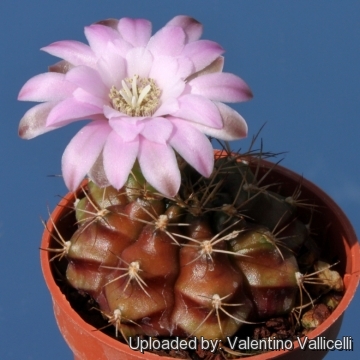 Gymnocalycium anisitsii Photo by: Valentino Vallicelli
Gymnocalycium anisitsii Photo by: Valentino Vallicelli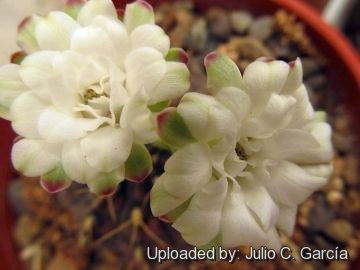 Gymnocalycium anisitsii Photo by: Julio C. García
Gymnocalycium anisitsii Photo by: Julio C. García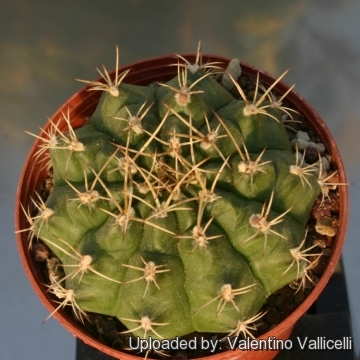 Gymnocalycium anisitsii Photo by: Valentino Vallicelli
Gymnocalycium anisitsii Photo by: Valentino Vallicelli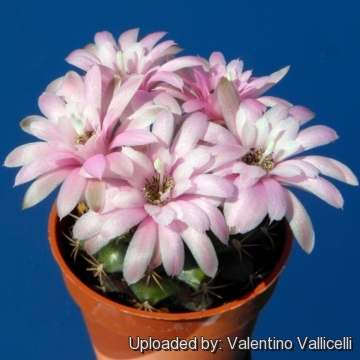 Gymnocalycium anisitsii Photo by: Valentino Vallicelli
Gymnocalycium anisitsii Photo by: Valentino Vallicelli Gymnocalycium anisitsii Photo by: Cactus Art
Gymnocalycium anisitsii Photo by: Cactus Art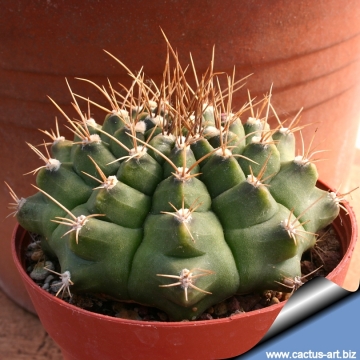 Gymnocalycium anisitsii Photo by: Cactus Art
Gymnocalycium anisitsii Photo by: Cactus Art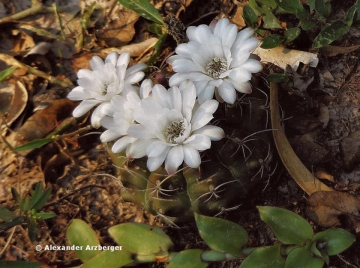 Habit at the type locality. Photo by: Alexander Arzberger
Habit at the type locality. Photo by: Alexander Arzberger In habitat. Photo by: Alexander Arzberger
In habitat. Photo by: Alexander ArzbergerCultivation and Propagation: Gymnocalycium anisitsiiSN|13315]]SN|13315]] is a summer grower species that is easy to cultivate.
Growth rate: It is a relatively rapidly growing and easily flowering species that will make clumps given the best conditions.
Soils: It likes very porous standard cactus mix soil. Prefer a low pH compost, avoid substrata rich in limestone; otherwise growth will stop altogether.
Repotting: This plant needs plenty of space for its roots, repotting should be done every other year or when the it has outgrown its pot. Use pot with good drainage.
Watering: Needs moderate to copious waterings in summer, but do not overwater (Rot prone), keep dry in winter at a minimum temperature of 0°C.
Fertilization: Feed with a high potassium fertilizer in summer.
Hardiness: Reputedly resistant to frost if kept on the dry side prior to, and during, cold weather (hardy to -5 C ° C, or less for short periods).
Exposition: The plant tolerates extremely bright situations but enjoys filtered sunlight or afternoon shade, inside it needs bright light, and some direct sun. Tends to bronze in strong light, which encourages flowering and heavy spine production, but is likely to suffer from sun scorch or stunted growth if over exposed to direct sunlight during the hottest part of the day in summer.
Uses: It is an excellent plant for container growing. It always looks good and stays small. It look fine in a cold greenhouse and frame or outdoor in a rockery.
Pests & diseases: It may be attractive to a variety of insects, but plants in good condition should be nearly pest-free, particularly if they are grown in a mineral potting-mix, with good exposure and ventilation. Nonetheless, there are several pests to watch for:
- Red spiders: Red spiders may be effectively rubbed up by watering the plants from above.
- Mealy bugs: Mealy bugs occasionally develop aerial into the new growth among the wool with disfiguring results, but the worst types develop underground on the roots and are invisible except by their effects.
- Scales: Scales are rarely a problem.
- Rot: This species is particularly easy and accommodating, seldom suffer of cryptogamic diseases. Rot it is only a minor problem with gymnocalyciums if the plants are watered and “aired” correctly. If they are not, fungicides won't help all that much.
Propagation: Division, direct sow after last frost. Seeds germinate in 7-14 days at 21-27° C in spring, remove gradually the glass cover as soon the plants will be well rooted (ca 1-2 weeks) and keep ventilated, no full sun for young plants! To make a cutting twist off a branch and permit it to dry out a couple of weeks, lay it on the soil and insert the stem end partially into the soil. Try to keep the cutting somewhat upright so that the roots are able to grow downward.
Your Photos

by Alexander Arzberger



















